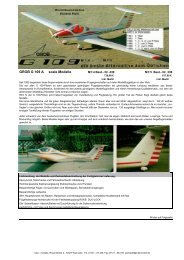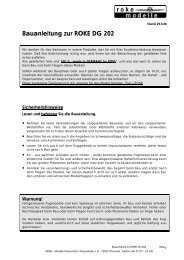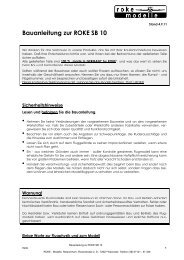Bedienungsanleitung Graupner JR mx-12 (englische Version) - ROKE
Bedienungsanleitung Graupner JR mx-12 (englische Version) - ROKE
Bedienungsanleitung Graupner JR mx-12 (englische Version) - ROKE
You also want an ePaper? Increase the reach of your titles
YUMPU automatically turns print PDFs into web optimized ePapers that Google loves.
Safety notes<br />
Please read carefully!<br />
We all want you to have many hours of pleasure in our<br />
mutual hobby of modelling, and safety is an important<br />
aspect of this. It is absolutely essential that you read<br />
right through these instructions and take careful note of<br />
all our safety recommendations. If you are a beginner to<br />
the world of radio-controlled model aircraft, boats and<br />
cars, we strongly advise that you seek out an experienced<br />
modeller in your field and ask him for help and<br />
advice. These instructions must be handed on to the<br />
new owner if you ever sell the transmitter.<br />
Application<br />
This radio control system may only be used for the<br />
purpose for which the manufacturer designed it, i.e. for<br />
operating radio-controlled models which do not carry humans.<br />
No other type of use is approved or permissible.<br />
Safety notes<br />
SAFETY IS NO ACCIDENT<br />
and …<br />
RADIO-CONTROLLED MODELS ARE NOT<br />
PLAYTHINGS<br />
Even small models can cause serious personal injury<br />
and damage to property if they are handled incompetently.<br />
Technical problems in electrical and mechanical systems<br />
can cause motors to rev up or burst into life unexpectedly,<br />
with the result that parts may fly off at great speed,<br />
causing considerable injury.<br />
Short-circuits of all kinds must be avoided at all times.<br />
Short-circuits can easily destroy parts of the radio control<br />
system, but even more dangerous is the acute risk of<br />
fire and explosion, depending on the circumstances and<br />
the energy content of the batteries.<br />
The circumstances and the energy content of the<br />
batteries.<br />
Aircraft and boat propellers, helicopter rotors, open<br />
gearboxes and all other rotating parts which are driven<br />
by a motor or engine represent a constant injury hazard.<br />
Do not touch these items with any object or part of your<br />
body. Remember that a propeller spinning at high<br />
speed can easily slice off a finger! Ensure that no<br />
other object can make contact with the driven components.<br />
Protect all electronic equipment from dust, dirt, damp,<br />
and foreign bodies. Avoid subjecting the equipment<br />
to vibration and excessive heat or cold. Radio control<br />
equipment should only be used in „normal“ ambient temperatures,<br />
i.e. within the range -15°C to +55°C. Avoid<br />
subjecting the equipment to shock and pressure.<br />
Check the units at regular intervals for damage to cases<br />
and leads. Do not re-use any item which is damaged<br />
or has become wet, even after you have dried it out<br />
thoroughly. Use only those components and accessories<br />
which we expressly recommend. Be sure to use only<br />
genuine matching GRAUPNER connectors of the same<br />
design with contacts of the same material. Use only<br />
genuine GRAUPNER plug-in crystals on the appropriate<br />
frequency band. When deploying cables note<br />
that they must not be under tension, and should never<br />
be bent tightly or kinked, otherwise they may fracture.<br />
Avoid sharp edges which could wear through the cable<br />
insulation.<br />
Check that all connectors are pushed home firmly<br />
before using the system. When disconnecting components,<br />
pull on the connectors themselves - not on the<br />
wires.<br />
It is not permissible to carry out any modifications to<br />
the RC system components. Avoid reverse polarity<br />
and short-circuits of all kinds, as the equipment is not<br />
protected against such errors.<br />
Installing the receiving system and deploying the<br />
receiver aerial<br />
In a model aircraft the receiver must be packed in soft<br />
foam and stowed behind a stout bulkhead, and in a<br />
model boat or car should be protected effectively from<br />
dust and spray.<br />
The receiver must not make contact with the fuselage,<br />
hull or chassis at any point, otherwise motor vibration<br />
and landing shocks will be transmitted directly to it.<br />
When installing the receiving system in a model with a<br />
glowplug or petrol engine, be sure to install all the components<br />
in well protected positions so that no exhaust<br />
gas or oil residues can reach the units and get inside<br />
them. This applies above all to the ON / OFF switch,<br />
which is usually installed in the outer skin of the model.<br />
Secure the receiver in such a way that the aerial, servo<br />
leads and switch harness are not under any strain.<br />
The receiver aerial is permanently attached to the receiver.<br />
It is about 100 cm long and must not be shortened<br />
or extended. The aerial should be routed as far away<br />
as possible from electric motors, servos, metal pushrods<br />
and high-current cables. However, it is best not to<br />
deploy the aerial in an exactly straight line, but to angle<br />
it: e.g. run it straight to the tailplane, then leave the final<br />
10 - 15 cm trailing down, as this avoids reception „blind<br />
spots“ when the model is in the air. If this is not possible<br />
we recommend that you lay out part of the aerial wire<br />
in an S-shape inside the model, close to the receiver if<br />
possible.<br />
Safety notes 3








